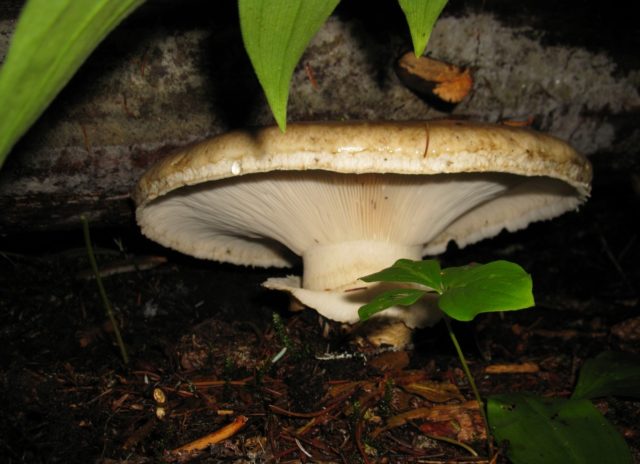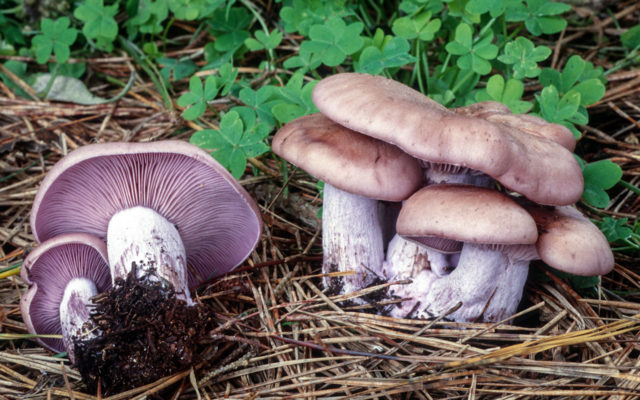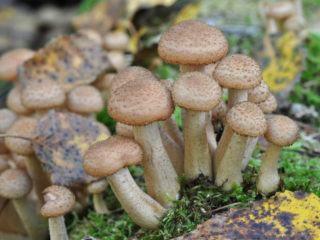Content
Catathelasma imperiale is a rare mushroom. Unfortunately, it does not grow in Russian forests. The regal mushroom is not always found even in the Alps.
It has a fairly extensive synonymous range, which includes not only biological, but also folk names:
- imperial champignon;
- korban;
- Carpathian truffle;
- Kozar;
- coniferous pistrick.

Finding such a mushroom is real luck
Where does catatelasma regal grow?
The fruiting bodies belong to the Catatelasma family.It grows in some countries of Europe and North America. Very rare in the south of Crimea. Prefers pine forests. They can grow singly or in small groups.
What does catatelasma imperial look like?
Mushrooms with an interesting name are classified as cap-legged. The description below indicates the features of each part of the catatelasma.
hat
Young mushrooms are distinguished by their hemispherical shape, with the thick edges folded inward. The edge unfolds, and the cap itself straightens, becomes spread out, resembling the shape of a pillow. The size is truly royal, growing up to 40 cm in diameter.
The surface of the cap is olive, chestnut, red-brown or brown. In young fruiting bodies - with mucus, as they grow, it becomes dry. Old catatelasmas can be distinguished by cracks.

Along the edges of the cap you can see white scales that remain after the cover is torn
Spore-bearing layer
The plates are initially covered with a thick blanket, which creates conditions for the maturation of ellipsoidal spores. When it breaks, a ring remains on the stem. The plates are located close to each other. With their wide bases they not only grow to the leg, but also run down it a little.

White spore powder
The spore-bearing layer is white or slightly yellowish in young Catatelasma regal, but in old fruiting bodies it turns brown.
Leg
The leg is medium in size, in height - from 5 to 15 cm, diameter - on average 8 cm. It tapers closer to the base. Near the hat there is a double ring left over from the bedspread.

The upper part of the leg is white, under the ring it is darker
Pulp
Catatelasma regal is famous for its special floury taste and aroma. The upper part of the cap of Catatelasma regal is granular; in old specimens it is covered with brown spots.

The pulp is white or grayish in color, very dense, boils down a little
Is it possible to eat imperial champignon?
Catatelasma regalis is an edible mushroom. It has excellent nutritional and culinary qualities and is universally used. Fruits can be:
- fry;
- cook;
- dry;
- marinate.
False doubles
It is impossible to say that the doubles of the royal catatelasma are false. The fact is that similar species are either edible or conditionally edible.
Violet row
This counterpart to Catatelasma regal is edible. Grows in mixed or coniferous forests in rows, circles or separate small groups. It got its name from the aroma of flowers, so it cannot be confused with anyone.
The row has a large cap - up to 15 cm. In young specimens it is purple, then turns pale. Legs light purple. Prized for its fleshy, firm flesh, it can become watery during rainy periods.
Fruiting begins in September, harvesting continues until October.

It is distinguished by dense pulp, but not everyone likes it, since the fibers are somewhat harsh
Row purple
This double of catatelasma regal is often found in pine forests or mixed forests. It begins to bear fruit in the fall. The last specimens can be collected even in November in the Southern regions. The species is classified as conditionally edible.

Purple row can be salted, fried, pickled, dried
Gray row
Large fruiting bodies are suitable for consumption. Young mushrooms need to be collected, as the cap of aging specimens becomes rotten. Grayish pulp with the taste and aroma of flour.
You need to look for fruiting bodies in places where there is a lot of moss.

The purpose of the gray row is universal
Rules for collection and use
You need to collect catatelasma using a sharp knife. Then remove pine needles, grass and soil and wash thoroughly. Catatelasma is added to soups, side dishes, and baking fillings.
Conclusion
Catatelasma regal is a delicious mushroom, but not many people get to try it. Not only are they found in a limited area, they are also listed in the Red Book.








